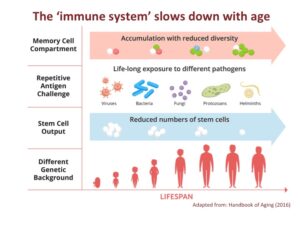Duration
6:00 minutes
Category
Stem cell therapy
Series
Immunity and aging
Objective
Educational
Can the aging immune system be rejuvenated?
What you will learn
- Aging of the immune system with age
- Can stem cells be use to rejuvenate the immune system?
- A case for cord blood stem cells for restoring immunity
- Ways to restore the immune system
- Potential sources of stem cells for cell therapy
This lesson delves into the extensive efforts of researchers worldwide to address the challenges posed by the aging immune system.

Daily, we encounter environmental pathogens. Fortunately, our immune system possesses the ability to recognize and eliminate these invaders, safeguarding our bodies from their detrimental effects. The importance of a robust immune system in effectively combating infections is evident.
In a prior lesson, we delved into the transformations that the immune system undergoes as we age. These alterations encompass a decline in memory cell diversity, reduced stem cell numbers, and DNA changes in stem cells, all of which can impact the immune system’s vigor and effectiveness. For a deeper understanding of this topic, refer to the lesson on immunity and aging.
This webinar zeroes in on the question: How can we address the predicament of the aging immune system? This subject is a highly pursued area of research.
 Researchers are exploring diverse strategies to rejuvenate the immune system, spanning from vaccinations to metabolic reprogramming. This discussion delves deeper into one such avenue: the revitalization of stem cells.
Researchers are exploring diverse strategies to rejuvenate the immune system, spanning from vaccinations to metabolic reprogramming. This discussion delves deeper into one such avenue: the revitalization of stem cells.
For instance, one highlighted study transplanted hematopoietic stem cells from both young and old donors into immune-deficient mice. Following the transplants, the newly developed immune systems of these mice were meticulously examined.
The results indicated that mice receiving young stem cells developed immune systems resembling those of young mice. Similarly, mice receiving old stem cells manifested immune systems akin to those of aged mice. This strongly implies that hematopoietic stem cells play a pivotal role in immune system aging.
Further promising signs of rejuvenation stem from parabiosis experiments in mice. In these experiments, the circulatory systems of a young and an old mouse are merged, leading to shared blood supplies.
Data gleaned from multiple parabiosis experiments suggest that this fusion revitalizes the cells and tissues of the old mouse. Essentially, the youthfulness of the blood revives the aged components.

For over 60 years, physicians have employed hematopoietic stem cell transplants for treating diseases like cancers, blood disorders, and immune system anomalies. Numerous clinical trials aim to expand the scope of stem cell transplants for treating a wider range of conditions.
Should stem cell transplants eventually emerge as a means to rejuvenate the hematopoietic stem cell population and consequently our immune systems, three primary stem cell sources come into play: bone marrow stem cells, induced pluripotent cells (iPS), and cord blood stem cells.

Considerations regarding bone marrow include the requirement for surgical donation and the necessity for these cells to originate from younger donors.
Induced pluripotent cells (iPS) are artificially generated from adult cells in laboratory settings. While these cells have proven valuable for stem cell research, their suitability and safety for cell therapy require further establishment.
 Cord blood, the blood left in the umbilical cord post-birth, holds hematopoietic stem cells, making it a promising source for stem cell therapy. However, the limitation lies in its availability only at birth.
Cord blood, the blood left in the umbilical cord post-birth, holds hematopoietic stem cells, making it a promising source for stem cell therapy. However, the limitation lies in its availability only at birth.
 Of these options, cord blood stands as a strong contender for cell therapy, owing to its collection and cryopreservation at birth. These cells represent the youngest possible stem cell source, with minimal aging factors, DNA damage, and long telomeres. As illustrated by previous stem cell transplant studies, the presence of young hematopoietic stem cells is crucial for rejuvenating an aging immune system.
Of these options, cord blood stands as a strong contender for cell therapy, owing to its collection and cryopreservation at birth. These cells represent the youngest possible stem cell source, with minimal aging factors, DNA damage, and long telomeres. As illustrated by previous stem cell transplant studies, the presence of young hematopoietic stem cells is crucial for rejuvenating an aging immune system.
In summary, a robust immune system is pivotal in defending against infections, and its efficacy diminishes with age due to immunosenescence. This susceptibility to infections, particularly life-threatening for the elderly, highlights the importance of addressing immune aging.
Promising research endeavors spotlight the potential to restore stem cell populations, specifically hematopoietic stem cells, in revitalizing the immune system. Whether stem cell transplants will emerge as a solution to rejuvenating immune function remains a subject of future revelation.
More topics you might like
Continue your journey by selecting another topic.
What are newborn stem cells and why are they important?
3:45 minutes | Stem cell basics
Understand the different types of stem cell transplants.
5:30 minutes | Stem cell basics
Find out more about how our immune systems change with age
4:30 minutes | Stem cell therapy





